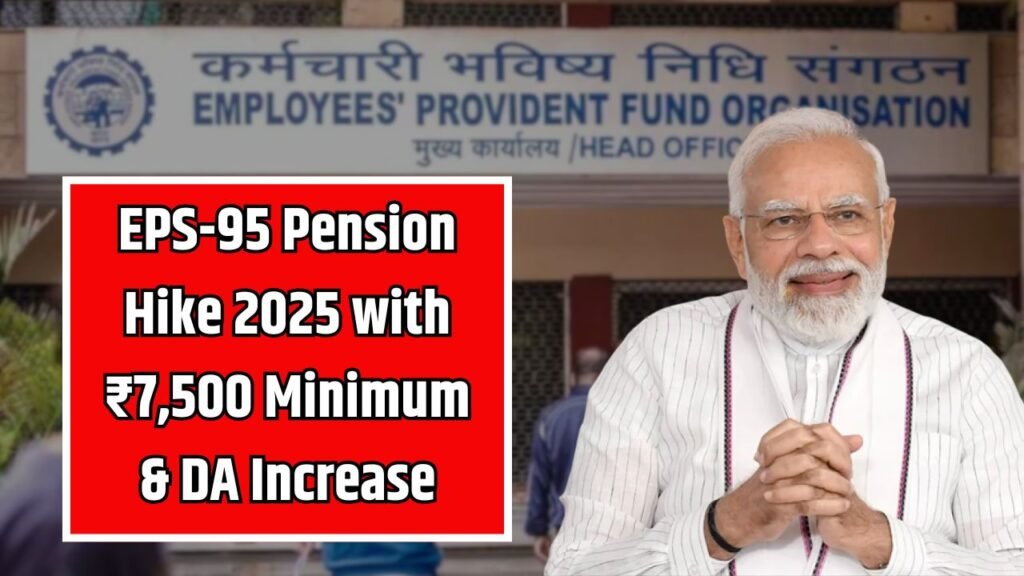The government has finally delivered a long-awaited relief to pensioners under the Employees’ Pension Scheme (EPS-95). Starting September 2025, the minimum monthly pension has been raised from ₹1,000 to ₹7,500. For the first time, Dearness Allowance (DA) will also be added, giving over 78 lakh retirees across India financial stability and dignity.
Why EPS-95 Pension Revision Was Needed
EPS-95 was launched in 1995 to provide retirement security for organized sector employees. However, for years, pensions remained at ₹1,000, leaving retirees struggling with basic expenses like food, medicine, and utilities. Rising inflation made life even harder. Pensioners’ associations protested and filed petitions demanding revision. The government’s new hike finally acknowledges their struggles.
| Issue | Before Hike | After Hike |
|---|---|---|
| Minimum Pension | ₹1,000 | ₹7,500 |
| Dearness Allowance | Not Applicable | Linked to CPI (Consumer Price Index) |
| Beneficiaries | Over 78 lakh retirees | Over 78 lakh retirees |
Supreme Court’s Role
This historic revision was influenced by years of legal action. EPS-95 pensioners approached the Supreme Court, highlighting the outdated and unfair system. The court directed the Employees’ Provident Fund Organisation (EPFO) and government to implement a fair pension structure. Following this, the government approved the ₹7,500 minimum pension with DA, marking a major social security reform.
Who Will Benefit
Not all retirees will get the revised pension automatically. The hike applies to:
- EPS-95 members with at least 10 years of service
- Retirees aged 58 or above
- Those drawing less than ₹7,500
| Beneficiary Type | Eligibility | Notes |
|---|---|---|
| Standard EPS-95 Pensioners | ≥10 years of service & age ≥58 | Automatic benefit |
| Central Pension Recipients | Multiple pensions | May not be eligible |
Dearness Allowance: A Game-Changer
For the first time, EPS-95 pensioners will receive DA linked to CPI, similar to central government employees. This ensures pensions rise with inflation, helping retirees maintain their purchasing power as essentials like groceries, medicines, and fuel become costlier.
Key Points About DA:
- Calculated based on Consumer Price Index (CPI)
- Adjusted every six months
- Prevents pension value erosion due to inflation
Impact on Government Finances
The EPS-95 pension hike will require thousands of crores annually, but the benefits extend beyond numbers:
- Increased disposable income for retirees
- Boost to local markets and small businesses
- Relief for families dependent on pensioners
- Better ability to handle rising medical and healthcare costs
| Aspect | Impact |
|---|---|
| Government Spending | Thousands of crores annually |
| Economic Boost | Higher spending by retirees supports local markets |
| Social Impact | Families and retirees feel financial relief |
Pensioners’ Reactions
Pensioners’ associations in states like Uttar Pradesh, Maharashtra, Punjab, and Tamil Nadu have welcomed the hike. Many retirees called it long-overdue recognition of their work. Unions continue to push for:
- Automatic DA revisions
- Alignment with Pay Commission recommendations
- Further hikes if inflation rises steeply
What This Means for the Future
The EPS-95 hike is more than financial; it shows India is committed to supporting its elderly population. Experts believe this reform could encourage:
- Improved social security for workers in the unorganized sector
- Better retirement benefits in the coming years
- Long-term financial protection for seniors
Conclusion
By raising the minimum EPS-95 pension to ₹7,500 and adding DA, the government has fulfilled a key demand of retirees. The move restores dignity and stability to millions of senior citizens while strengthening India’s social security framework.





